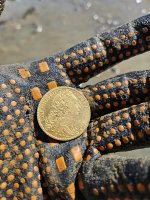piratediver
Sr. Member
Wreckage of 17th-century Dutch cargo ship found near Brazil
Budapest (Hungary): A team of Hungarian marine archaeologists has found the wreckage of a Dutch cargo ship that sank near the Brazilian coast over three centuries ago.
Voetboog was a three-mast flyboat, which left the port of Batavia (now Jakarta) for The Netherlands with a 109-member crew on board, the expedition leader Attila K. Szaloky told MTI, a Hungarian news agency.
Owned by the Dutch East India Company, the Fluyt ship carried silk, spices, tea, Japanese and Chinese porcelain as well as nearly 180,000 pieces of Dutch golden ducats.
"The estimated value of the wreckage is about 1 billion dollars," said Szaloky.
Sailing on the Atlantic, the ship was probably caught by a storm and its only chance to get home was to stick close to the Brazilian coast.
For reasons unknown, however, it sank near the coast of Pernambuco state on May 29, 1700.
The team of Octopus Association for Marine Archaeology found the wreckage in October 2008, but announced the discovery only after the first phase of examinations came to an end.
The objects found in the depths suggest that it is indeed the wreckage of Voetboog, which is lying on the seabed under several metres thick of sediment.
"Over the past 309 years, the ship has virtually disintegrated," Szaloky said.
The finds will be brought to surface and conserved in line with Brazilian law.
Budapest (Hungary): A team of Hungarian marine archaeologists has found the wreckage of a Dutch cargo ship that sank near the Brazilian coast over three centuries ago.
Voetboog was a three-mast flyboat, which left the port of Batavia (now Jakarta) for The Netherlands with a 109-member crew on board, the expedition leader Attila K. Szaloky told MTI, a Hungarian news agency.
Owned by the Dutch East India Company, the Fluyt ship carried silk, spices, tea, Japanese and Chinese porcelain as well as nearly 180,000 pieces of Dutch golden ducats.
"The estimated value of the wreckage is about 1 billion dollars," said Szaloky.
Sailing on the Atlantic, the ship was probably caught by a storm and its only chance to get home was to stick close to the Brazilian coast.
For reasons unknown, however, it sank near the coast of Pernambuco state on May 29, 1700.
The team of Octopus Association for Marine Archaeology found the wreckage in October 2008, but announced the discovery only after the first phase of examinations came to an end.
The objects found in the depths suggest that it is indeed the wreckage of Voetboog, which is lying on the seabed under several metres thick of sediment.
"Over the past 309 years, the ship has virtually disintegrated," Szaloky said.
The finds will be brought to surface and conserved in line with Brazilian law.



 And what is in the background? Nothing, just an arrogant liar: Szaloky.
And what is in the background? Nothing, just an arrogant liar: Szaloky. 
